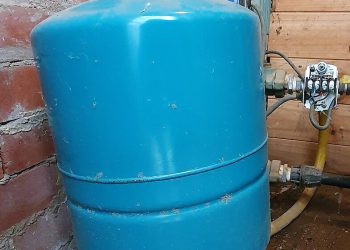An overflow of wastewater from the city sewer or municipal drainage system can sometimes make it into your home and cause much damage.
This is usually due to pipes breaking, too much snowmelt or rain, tree roots blocking the pipes, or an issue with your plumbing systems, such as a sump pump failing, hair clogs, grease clogs, or some other physical obstruction.
Fortunately, there are ways to help protect your home from this kind of disaster by installing a sewer backflow preventer.
Adding a sewer backflow preventer to your plumbing system can help protect your home from nasty sewer overflow issues. But just what is a sewer backflow preventer, and how does it work?
How does a sewer backflow preventer work?
It’s a device that prevents sewage or water from entering your home through the sewage system when the main line gets too full.
The preventer has a small flap that’s usually open to let water and sewer vapors flow out of your home. It also has floaters on both sides of the flap, allowing it to open and close.
If water or sewage starts to flow back into your home, the floaters will make the flap close and stop the water from coming in. Once the water stops flowing in the wrong direction, the flap will open again and allow water and sewage to continue to flow out of your home.
To check if your preventer is working correctly, look at the clear-cover access box on the backwater preventer. This simple device is important to keeping your home safe from sewage backups.
Does every house need a sewer backflow preventer?
Backflow preventers are an important safety device for homes located in areas with potential flooding or sewage backup. These devices are installed in the home’s sewer line and work to ensure that only clean, treated water flows back into local sewers and rivers.
Backflow preventers also guard against contaminants in drinking water supplies and protect aquatic habitats by blocking the flow of pollutants. Installing a backflow preventer is especially important if your home is near a river, lake, or ocean.
These locations have a higher risk of experiencing flooding or sewage backup events. In many areas, it is now required by law that all residential homes have such devices installed.
Check with your local jurisdiction to find out more about sewer backflow regulations.
What are the benefits of installing a sewer backwater preventer in your home?
A sewer backwater preventer can provide several benefits for your home, including:
- Preventing sewage backups: The primary benefit of a sewer backwater preventer is that it helps prevent sewage backups in your home. This device stops sewage from flowing back into your house through the sewer line during heavy rain or flooding.
- Protecting your property: Sewage backups can cause extensive damage to your property, including floors, walls, and furniture. By installing a backwater preventer, you can protect your property from costly repairs and restoration.
- Improving public health: Sewage backups can also pose a risk to public health by exposing people to harmful bacteria and other contaminants. A backwater preventer helps keep these contaminants out of your home and the surrounding environment.
- Reducing insurance premiums: Some insurance companies offer discounts on homeowner’s insurance policies if you have a sewer backwater preventer installed in your home. This is because it reduces the risk of expensive claims related to sewage backups.
Installing a sewer backwater preventer can provide peace of mind knowing that you’re protecting both your home and the environment from the damaging effects of sewage backups.
You might be interested: Real Buyer Reviews of Water Worker Pressure Tank: Should You Invest in One?
Are there any risks associated with not having a sewer backflow preventer?
Not having a backflow preventer installed in your home’s sewer line could lead to various risks, including the potential for sewage or other contaminants to enter your home’s drinking water supply.
In addition, these contaminants could also pollute nearby bodies of water, such as rivers, streams, or lakes. This could impact wildlife and aquatic habitats, putting them at risk of contamination and potential damage.
As such, it is important to ensure that your home has a properly installed and maintained backflow preventer to reduce the risk of such problems.
How is a sewer backflow preventer installed?
If you’re wondering how a sewer backflow preventer is installed, here are the basic steps:
- Figure out where to put it: The first step is finding the best spot for the backflow preventer. It should be downstream from anything that could make it dirty and upstream from anything that might cause pressure.
- Install the device: Once you know where to put it, you have to install the backflow preventer by cutting into the sewer line and doing what the manufacturer says.
- Connect it to your plumbing system: After installation, connect the device to your plumbing system. This could mean hooking it up straight to a fixture or using a bypass valve to connect it alongside your current plumbing.
- Test and inspect: Lastly, test and inspect your backflow preventer regularly to make sure it’s working properly and keeping sewage backups away.
It’s important to remember that installing a sewer backflow preventer can be tricky and should only be done by an experienced licensed plumber or contractor.
There are three sewer backflow preventers: a sewer check valve, an automatic floodgate valve, and a manual sewer gate valve. There are also specialized backflow preventers, and each has its effectiveness.
Types of Sewer Backflow Preventers
Automatic Flood Gate Valve
Installing an Automatic Flood Gate Valve is a great way to protect your home from wastewater and associated risks. It consists of a stainless steel knife that completely blocks backwater, even over long periods.
However, because it is larger than the usual preventer and requires special training to install, it’s essential to ensure it’s done properly; failing to do so could reduce the system’s effectiveness and void the warranty.
Sewer Check Valve
A Sewer Check Valve is a cost-friendly and commonly used backwater preventer. It’s usually applied in temporary backups lasting no more than one day.
To ensure your check valve remains efficient, clean it at least once a year. As soon as the public overflow weakens, your home’s wastewater will flow out and away to the public sewer.
This means water use within the building should be limited when the flapper closes.
Manual Sewer Gate Valve
A Manual Sewer Valve is an ideal solution for situations where a backwater issue is anticipated, and you know when it will be gone.
This type of valve must be opened and closed manually, making it the perfect choice for these specific needs.
Air Gap Backflow Preventer
The Air Gap Backflow Preventer is a reliable and cost-efficient way to avoid water and sewage backflows in your home.
It is simply an open vertical space between any device that connects to a plumbing system, such as the gap between a faucet and a kitchen sink’s flood level.
Even when pressure comes from the water supply, the air gap prevents flow from the sink to the tap. Plus, you won’t need moving parts since surging water will do the preventative job for you.
Additionally, many plumbing codes have specified minimum air gaps for several fixtures.
Specialized Backflow Preventer
A Specialized Backflow Preventer is usually installed near a residential water meter after the shut-off valve. There are various models available, such as the Pressure Vacuum Breaker (PVB), the Reduced Principle (RP), and the Residential Dual Check Valve (RDC).
These have moving parts and require regular cleaning and testing to ensure they work properly. A licensed plumber must perform this test since only their expertise yields accurate results for drinking water supply reports in most states.
The installation must also follow plumbing code requirements, which licensed professionals best do.
Conclusion
Sewer backflow preventers are designed to keep your home safe from contaminated water flow which can contain harmful pathogens like fungi, bacteria, parasites, and viruses. With a good installation, regular cleaning, and annual inspection, your backwater valve can function properly for many years. Likewise, keeping the plumbing system free of unnecessary materials such as diapers, cigarette butts, and napkins will also extend its life.




















